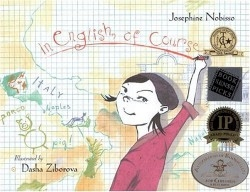In English, of Course
There are two Josephines to this story-the author and her autobiographical character. The author was born in the Bronx to Italian immigrant parents in 1953 and grew up there in Little Italy. Her father worked as a bricklayer; Nobisso explains in a postscript that she changed the father’s profession to architectural engineer to help show the “talents, dignity (and wit!) of newcomers to a country.” Storybook Josephine was born in Italy, and moved to the Bronx with memories of her homeland that she can only communicate in Italian.
Both Josephines must learn to speak in English, of course, when they attend school.
Drawing on her experience, and a subsequent career in teaching her method of learning language, the author shares with humor and compassion the difficulties of communicating in a foreign tongue.
When storybook Josephine goes to school, she and the other students are encouraged to tell, in English, about their native lands. Josephine knows that Naples, Italy, is a sophisticated city, but she doesn’t know the English words to express that. The teacher prompts her by asking questions, such as if she used to live on a farm. Using words she recognizes, Josephine says that she has been to a farm one time; the teacher encourages her to tell more. Cleverly, she acts out concepts, such as “kick,” and her teacher tells her the words so she can to tell her story, in English.
“When that cow she kick me, I falling down in river. That cow, she hiding, but that pig, he push cow in river.” Josephine says she ended up with “much river in mouth.”
Nobisso is the author of several books, and won five awards for John Blair and the Great Hinckley Fire. The illustrator, also an immigrant (from Russia), uses a retro-style of illustration that visually sets the story during the time of the author’s childhood. The figures, evocative of Make Way for Ducklings (1941), or line art in appliance instruction books from the 1950s, have occasional accents of color-sometimes through collage-for clothing, hair, and background, with “skin” often left white. Josephine wears droopy anklets and a perky red suit, and her teacher sports a wide tie with his pinstriped suit. There is chalk for the blackboards (something today’s children don’t often see in the classroom), and a convertible car with fins.
Nobisso’s point, particularly well conveyed to elementary school students, is that nonspeakers of the English language are smarter than they may appear when they are first kicked by the educational cow and thrown in the linguistic river, surfacing with a mouth full of new vocabulary.
Reviewed by
Linda Salisbury
Disclosure: This article is not an endorsement, but a review. The publisher of this book provided free copies of the book to have their book reviewed by a professional reviewer. No fee was paid by the publisher for this review. Foreword Reviews only recommends books that we love. Foreword Magazine, Inc. is disclosing this in accordance with the Federal Trade Commission’s 16 CFR, Part 255.

